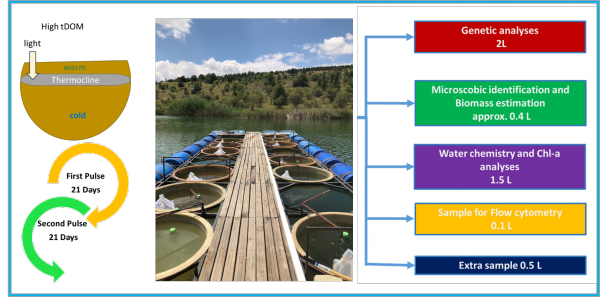TÜBİTAK 1001: R3-DOC
TUBITAK 1001 (119Y265): Resistance, Resilence and Recovery of Microbial and Plankton Community to Climate-induced re-current pulse tDOC disturbance in freshwater lakes: mesocosms study (Acronym: R3-DOC)
Funded by: TUBITAK, budget: 746,712.00 TL
Direction: Prof. Dr. Meryem Beklioğlu (PI), Assist. Prof. Dr. Emmanuel (Manolis) LADOUKAKIS (Researcher), Assoc. Prof. Dr. Efe Sezgin (Researcher)
Project Background:
Global climate change threatens freshwater ecosystems structures and function through dramatic loss in diversity (Woolway and Merchant 2019). Multiple climate models predict major changes in precipitation patterns (Knutti and Sedláček, 2013) with enhanced net precipitation with flush floods in the North temperate zone (IPCC, 2014) and Mediterranean climate regions (Polade et al. 2017) that has current implications in Turkey (Oktay Akkoyunlu, Baltaci, and Tayanc 2019). Such variations in precipitation regimes will expose aquatic communities to increased transport of materials in various forms including dissolved, particulate organic and inorganic matters from terrestrial ecosystems through catchment runoff (IPCC, 2007; HELCOM, 2007) especially to terrestrial dissolved organic carbon (tDOC), which is known to have a profound control on lake ecosystem structure and function (Robidoux et. al 2015; Seekell et al. 2015). Higher load of tDOC to aquatic ecosystems causes increased turbidity as well nutrient availability that may alter composition and biomass of primary producers, microbial production, shifts in metabolic rates, biogeochemical processes, and foodweb dynamics (Degerman et al. 2018).
Objective:
Through proposed mesocosms experiment, we will be able to test response of communities in terms of resistance, resilience and recovery. We will test resistance (insensitivity to disturbance) and the recovery of the communities by comparing the community structure before and after the disturbance. Also, we will test resilience (the rate of recovery) using a series of samples after two consecutive disturbances. Finally, we will test for functional redundancy of the communities.
Hypothesis:
We expect that, the more resistant and resilient a system is, the faster it will recover after the disturbance and the more similar will be with the initial system. Also, the more redundant a system is, the functional diversity will remain similar but the taxonomic structure of the communities will change.
Methodology:
To test how does the freshwater community responds to DOC disturbance as a result of flush-floods received in Mediterrenean regions, we will use a METU Mesocosm System as a controlled experimental setup. Proposed mesocosm system will follow factorial design (2 treatment x 4 replicates) with 4 replicates of control, local tDOC and highly standardized Humid-feed DOC. To simulate flush-floods, DOC will be added in re-current pulsed manner to treatment tanks in the 2nd and 6th weeks of the 9 week- lasting experiment. We will investigate changes in system dynamics before and after the first and second pulse disturbance-in terms of response, recovery and resilience through the changes in species and functional traits diversity, and species and community abundances and biomass. Microbial and plankton communities including bacteria, HNF, ciliates, phytoplankton and zooplankton species will be investigated from daily to weekly sampling time frames. For the further detailed investigation of the changes in plankton and microbial community structure, Next Generation Sequencing (NGS) Illumina amplicon sequencing of 16SRNA and 18SRNA will be performed along with the biomass estimations for which microscopic identification of organisms will be undertaken.

